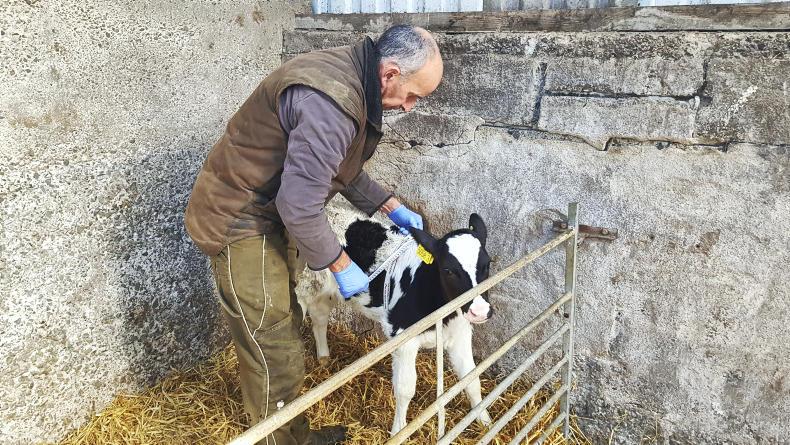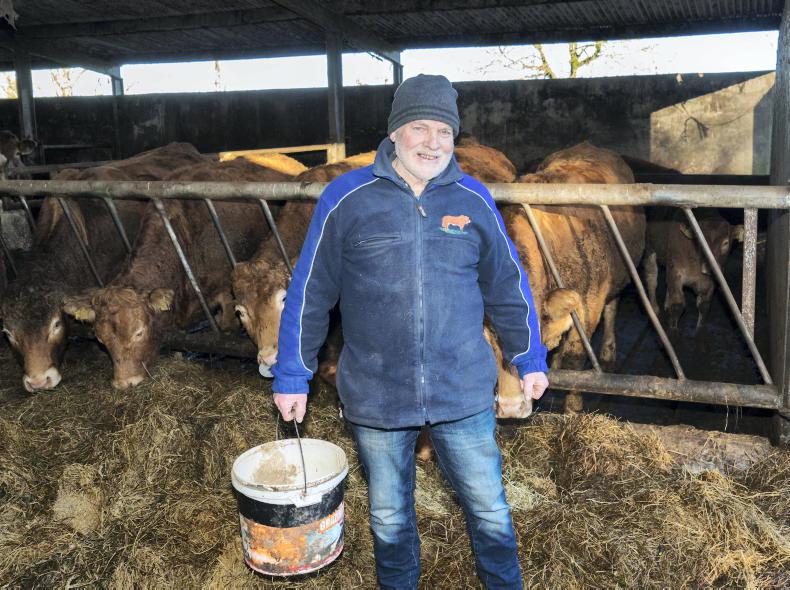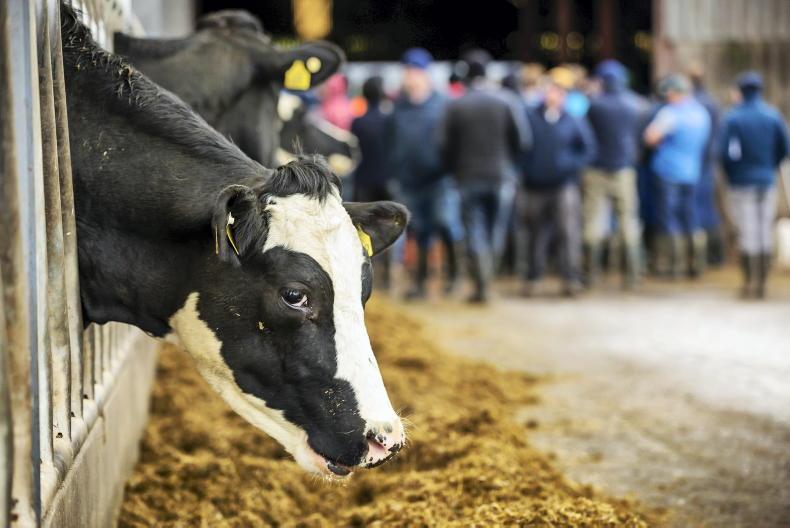The calf shed is a busy place on Stephen Wallace’s farm near Seaforde.
The Co Down man is in the middle of calving and, with his herd’s calving profile tightening in the past year, more new-born calves are arriving in a shorter space of time.
Although it means more work now, two advantages of a more compact calving block are that calf rearing will be finished up sooner and heifer calves will be more uniform, which simplifies management right up until they calve down themselves.
There are 90 late lactation cows still going through the parlour at present and drying off continues weekly
There are 65 cows calved so far and most calves are still on the farm, with only 10 bull calves sold.
Stephen has 40 calves in individual pens in the main calf shed. Older calves have been moved across the yard and are grouped into pens of three.
There are 90 late lactation cows still going through the parlour at present and drying off continues weekly.
Calving on the Wallace farm should be finished up by early February, which is significantly earlier than previous years when it ran on until May.
Weigh band
Dairylink Ireland participants track liveweights and growth rates of replacement heifers by periodic weighing.
On Stephen’s farm, a weigh band is used initially and electronic weigh scales are used after weaning.
The weigh band is a tape which gives an estimate of calf weight based on chest width. It is placed around the chest behind the front legs and shoulder blade.

Dairylink Ireland adviser Dr Aidan Cushnahan with programme participant Stephen Wallace.
Periodic weighing of heifers allows better informed decisions to be made in the calf shed and means any issues with below-target growth rates can be identified and corrected early.
Stephen uses the weigh band initially as it is less time consuming than getting calves out of their pens and on to the electronic scales.
The oldest heifers were measured last week and had an average daily liveweight gain of 0.67kg from birth.
However, the range weight gains between individual calves varied from 0.42-0.93kg/day.
The aim for Dairylink participants is to double birth weights by the time calves start to be weaned off milk at around eight weeks.
So, for a 40kg birthweight calf, this means a daily liveweight gain of 0.71kg.
Target
From weaning to breeding, the main target with heifer rearing on programme farms is to achieve a daily gain of 0.8kg.
This should allow heifers to hit 60% of their mature liveweight by breeding at 14-15 months.
Stephen has a good stock of calf jackets, but he hasn’t used them on many calves so far this year.
The calf shed on the Wallace farm is airy and well ventilated, but it can be cold at night
Dairylink Ireland adviser Dr Aidan Cushnahan is recommending that he puts them on new-born calves and any older calves that have been hitting less than 0.5 daily liveweight gain.
The calf shed on the Wallace farm is airy and well ventilated, but it can be cold at night, so the jackets let calves use more energy for growth instead of keeping warm.
Feed rate
The other piece of advice from Aidan is to increase the amount of milk being offered to calves.
Stephen is currently feeding pasteurised whole milk at 6l/calf/day on average. The plan is to gradually increase this to 9l/calf/day over the next two weeks.
Some calves on the Wallace farm are also being moved on to milk replacer, to reduce the demand on milk from the bulk tank.
Stephen has bought whey-based milk replacer with 23% crude protein and 18% crude fat.

The plan is to have calves on the Wallace farm consuming 900g/calf/day of milk replacer.
The plan is to get calves consuming 900g/calf/day of milk replacer to keep growth rates pushing on.
It will be mixed at 150g/l, meaning calves are drinking 6l of mixed milk each day over two feeds.
However, Stephen will need to be vigilant for any signs of scour in these calves, as the high feed rate can easily lead to nutritional scour issues.
If this does occur, he will reduce the milk replacer feed rate to 800g/calf/day.
He recently purchased a milk kart and pump for transporting whole milk and milk replacer from the dairy to calf shed
With more calves to feed this autumn, Stephen has looked at improving labour efficiency in the calf shed.
He recently purchased a milk kart and pump for transporting whole milk and milk replacer from the dairy to calf shed.
Prior to this, milk was moved in buckets on a trolley, which had an increased risk of spillages.
Read more
Watch: Dairylink – early lactation management in Derry
Dairylink: monitoring cow body condition in Down
The calf shed is a busy place on Stephen Wallace’s farm near Seaforde.
The Co Down man is in the middle of calving and, with his herd’s calving profile tightening in the past year, more new-born calves are arriving in a shorter space of time.
Although it means more work now, two advantages of a more compact calving block are that calf rearing will be finished up sooner and heifer calves will be more uniform, which simplifies management right up until they calve down themselves.
There are 90 late lactation cows still going through the parlour at present and drying off continues weekly
There are 65 cows calved so far and most calves are still on the farm, with only 10 bull calves sold.
Stephen has 40 calves in individual pens in the main calf shed. Older calves have been moved across the yard and are grouped into pens of three.
There are 90 late lactation cows still going through the parlour at present and drying off continues weekly.
Calving on the Wallace farm should be finished up by early February, which is significantly earlier than previous years when it ran on until May.
Weigh band
Dairylink Ireland participants track liveweights and growth rates of replacement heifers by periodic weighing.
On Stephen’s farm, a weigh band is used initially and electronic weigh scales are used after weaning.
The weigh band is a tape which gives an estimate of calf weight based on chest width. It is placed around the chest behind the front legs and shoulder blade.

Dairylink Ireland adviser Dr Aidan Cushnahan with programme participant Stephen Wallace.
Periodic weighing of heifers allows better informed decisions to be made in the calf shed and means any issues with below-target growth rates can be identified and corrected early.
Stephen uses the weigh band initially as it is less time consuming than getting calves out of their pens and on to the electronic scales.
The oldest heifers were measured last week and had an average daily liveweight gain of 0.67kg from birth.
However, the range weight gains between individual calves varied from 0.42-0.93kg/day.
The aim for Dairylink participants is to double birth weights by the time calves start to be weaned off milk at around eight weeks.
So, for a 40kg birthweight calf, this means a daily liveweight gain of 0.71kg.
Target
From weaning to breeding, the main target with heifer rearing on programme farms is to achieve a daily gain of 0.8kg.
This should allow heifers to hit 60% of their mature liveweight by breeding at 14-15 months.
Stephen has a good stock of calf jackets, but he hasn’t used them on many calves so far this year.
The calf shed on the Wallace farm is airy and well ventilated, but it can be cold at night
Dairylink Ireland adviser Dr Aidan Cushnahan is recommending that he puts them on new-born calves and any older calves that have been hitting less than 0.5 daily liveweight gain.
The calf shed on the Wallace farm is airy and well ventilated, but it can be cold at night, so the jackets let calves use more energy for growth instead of keeping warm.
Feed rate
The other piece of advice from Aidan is to increase the amount of milk being offered to calves.
Stephen is currently feeding pasteurised whole milk at 6l/calf/day on average. The plan is to gradually increase this to 9l/calf/day over the next two weeks.
Some calves on the Wallace farm are also being moved on to milk replacer, to reduce the demand on milk from the bulk tank.
Stephen has bought whey-based milk replacer with 23% crude protein and 18% crude fat.

The plan is to have calves on the Wallace farm consuming 900g/calf/day of milk replacer.
The plan is to get calves consuming 900g/calf/day of milk replacer to keep growth rates pushing on.
It will be mixed at 150g/l, meaning calves are drinking 6l of mixed milk each day over two feeds.
However, Stephen will need to be vigilant for any signs of scour in these calves, as the high feed rate can easily lead to nutritional scour issues.
If this does occur, he will reduce the milk replacer feed rate to 800g/calf/day.
He recently purchased a milk kart and pump for transporting whole milk and milk replacer from the dairy to calf shed
With more calves to feed this autumn, Stephen has looked at improving labour efficiency in the calf shed.
He recently purchased a milk kart and pump for transporting whole milk and milk replacer from the dairy to calf shed.
Prior to this, milk was moved in buckets on a trolley, which had an increased risk of spillages.
Read more
Watch: Dairylink – early lactation management in Derry
Dairylink: monitoring cow body condition in Down











SHARING OPTIONS